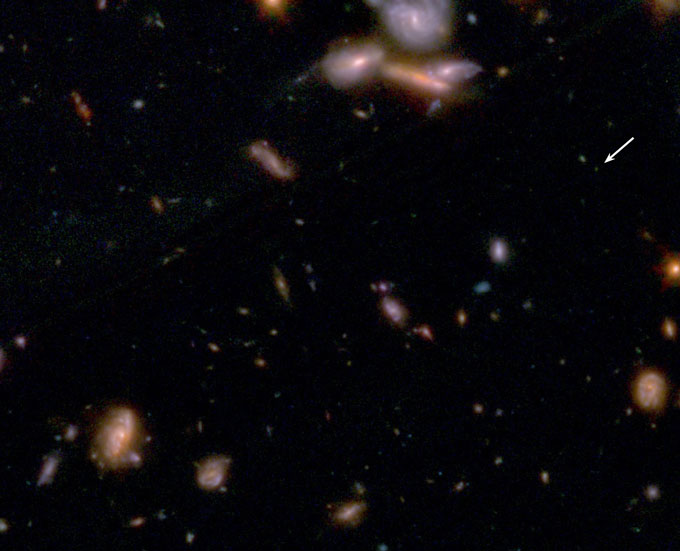The James Webb Space Telescope has spotted objects in the early universe that might be a new kind of star — one powered by dark matter.
These “dark stars” are still hypothetical. Their identification in JWST images is far from certain. But if any of the three candidates — reported in the July 25 Proceedings of the National Academy of Sciences — turn out to be this new type of star, they could offer a glimpse of star formation in the early universe, hint at the nature of dark matter and possibly explain the origins of supermassive black holes.
First proposed in 2007 by cosmologist Katherine Freese and colleagues, dark stars might have been some of the first types of stars to form in the universe (SN: 1/1/08). Though dark stars have yet to be observed, they’re thought to be powered by heat from dark matter interactions rather than by nuclear fusion reactions like in the sun.
Dark stars “would be very weird looking,” says Freese, of the University of Texas at Austin. The hypothetical stars would have formed from clouds of hydrogen and helium that drew in locally abundant dark matter as they coalesced. Though the true nature of dark matter isn’t known — its presence is inferred largely via its effect on how stars move within galaxies — it’s possible that dark matter particles can interact with themselves, annihilating each other when they collide and producing vast amounts of light and heat (SN: 7/7/22). That heat would keep the cloud of hydrogen and helium from condensing into a dense, hot core like the stars that exist today.
Because the heat from dark matter annihilations would keep the gas cloud from condensing, dark stars could grow to gargantuan size. Theoretically, dark stars could be 10 times as wide as Earth’s orbit around the sun. They could also be millions of times as massive as the sun and shine billions of times brighter — bright enough, potentially, to be spotted by JWST.
To see if any dark stars are lurking in data from the orbiting observatory, Freese and colleagues pored over images from a JWST survey of early galaxies. In such images, JWST has so far discovered over 700 objects that may have originated in the first few hundred million years of the universe — the epoch when dark stars would have emerged (SN: 12/16/22). Light from these remote objects is stretched, or redshifted, as the universe expands. So Freese and colleagues zeroed in on four objects already confirmed to be highly redshifted, making them some of the oldest objects seen to date.
Those objects are currently thought to be small galaxies from the universe’s relative infancy. But because they’re so far away, JWST can’t resolve them well enough to determine whether they’re actually galaxies or large, ultrabright stars, the researchers say.

The team ran computer simulations of how much light a hypothetical dark star might produce at various wavelengths. They compared those spectra to light from images collected by JWST at different wavelengths for each of the four objects. JWST data from three of those objects are consistent with the simulated dark star patterns, Freese and colleagues report.
Some scientists are skeptical. Known types of stars could also create the observed light from the three candidates, says Sandro Tacchella, an astrophysicist at the University of Cambridge. And identifying any of the objects as a dark star would require that the simulated patterns fit well to more detailed spectra, says Brant Robertson, a theoretical astrophysicist at the University of California, Santa Cruz.
If dark stars were to be found, though, “that would be revolutionary,” says study coauthor Cosmin Ilie, an astrophysicist at Colgate University in Hamilton, N.Y.
Detecting dark stars would confirm the existence of a dark matter particle and hint at how it works (SN: 7/7/22). “Just having the information that [dark matter] is something that could annihilate would be really, really powerful,” says Tracy Slatyer, a theoretical physicist at MIT who was not involved in the study. That knowledge could help scientists look for dark matter elsewhere in the universe, she says.
Dark stars could also help explain the formation of supermassive black holes (SN: 3/16/18). Once the dark matter inside the star has annihilated itself, the remaining hydrogen and helium — millions of times the mass of the sun in a relatively compact space — would collapse in on itself and form a black hole. Those black holes could merge over time into black holes like the ones at the centers of most galaxies, millions or billions of times as massive as the sun.
Future experiments, like looking for brighter or dimmer light at certain wavelengths, could help confirm whether any of the three objects are dark stars. Freese also expects to find more dark star candidates in future JWST data, she says. But for now, whether dark stars truly exist remains a mystery.
For all the latest Technology News Click Here
For the latest news and updates, follow us on Google News.
